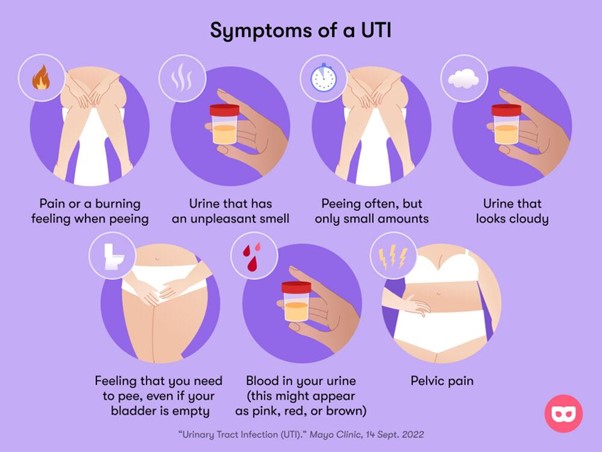A nurse is providing teaching to a client about measures to prevent urinary tract infections (UTIs). Which of the following client statements indicates a need for further teaching?
"I will need to drink apple cider vinegar each day."
“I will need to wipe my perineal area from back to front after urination."
“I need to drink 8 cups of liquid each day.
"I will need to empty my bladder regularly and completely.”
The Correct Answer is B
A. "I will need to drink apple cider vinegar each day."
This statement is incorrect. Drinking apple cider vinegar is not a proven method to prevent urinary tract infections (UTIs). The client does not need to consume apple cider vinegar as a preventive measure for UTIs.
B. “I will need to wipe my perineal area from back to front after urination."
This statement is incorrect and indicates a need for further teaching. Proper hygiene is essential in preventing UTIs, and wiping from back to front can introduce bacteria from the anal area to the urethra, increasing the risk of UTIs. The correct technique is to wipe from front to back after urination to prevent the spread of bacteria.
C. “I need to drink 8 cups of liquid each day."
This statement is correct. Staying well-hydrated by drinking an adequate amount of fluids, such as 8 cups of liquid each day, can help flush out bacteria from the urinary tract and reduce the risk of UTIs. Proper hydration is a good preventive measure.
D. "I will need to empty my bladder regularly and completely.”
This statement is correct. Emptying the bladder regularly and completely helps prevent the accumulation of bacteria in the urinary tract. Incomplete emptying of the bladder can allow bacteria to multiply, increasing the risk of UTIs. Regular and thorough emptying of the bladder is an important preventive measure against UTIs.
Nursing Test Bank
Naxlex Comprehensive Predictor Exams
Related Questions
Correct Answer is A
Explanation
A. Urinary tract infection
The symptoms described, including recent mental status changes and periods of incontinence, are suggestive of a urinary tract infection (UTI) in an elderly individual. UTIs are common among older adults and can cause a variety of symptoms, including confusion, which is often the primary manifestation in the elderly population. Other symptoms can include urinary urgency, frequency, and incontinence.
B. Acute kidney failure - While acute kidney failure can cause changes in urination and mental status, it is less likely to be the primary cause of these symptoms in this scenario. UTI is a more common and immediate concern given the symptoms described.
C. Septic shock - Septic shock is a severe condition that occurs when an infection leads to a life-threatening drop in blood pressure. While septic shock can cause altered mental status, it is a critical condition that often presents with more dramatic symptoms and requires immediate intensive care management. The symptoms described are more suggestive of a UTI.
D. Urinary stasis - Urinary stasis refers to the slowing or cessation of urine flow. While urinary stasis can contribute to the development of UTIs, it is not a condition that would cause sudden and acute mental status changes and incontinence on its own. UTI is a more likely cause of the symptoms described.

Correct Answer is ["84.1"]
Explanation
Weightinkg=185÷2.2≈84.1
Calculate the dose of enoxaparin:
The prescribed dose is 1 mg/kg.
Doseinmg=Weightinkg×Doseperkg
Doseinmg=84.1×1≈84.1
The nurse should administer 84.1 mg of enoxaparin.
Whether you are a student looking to ace your exams or a practicing nurse seeking to enhance your expertise , our nursing education contents will empower you with the confidence and competence to make a difference in the lives of patients and become a respected leader in the healthcare field.
Visit Naxlex, invest in your future and unlock endless possibilities with our unparalleled nursing education contents today
Report Wrong Answer on the Current Question
Do you disagree with the answer? If yes, what is your expected answer? Explain.
Kindly be descriptive with the issue you are facing.
